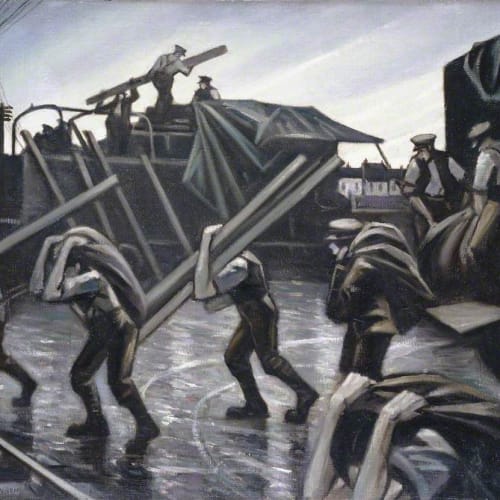Christopher Richard Wynne Nevinson NEAC ARA (13 August 1889 – 7 October 1946) was an English figure and landscape painter, etcher and lithographer, and one of the most famous war artists of World War I. He was an Associate of the Royal Academy and an active member of the New English Art Club in the early 20th Century, and one of the leading artists of British Modernism with his strong draughtsmanship and cubist style and influence.
Nevinson studied at the Slade School of Art under Henry Tonks and alongside Stanley Spencer and Mark Gertler. When he left the Slade, Nevinson befriended Marinetti, the leader of the Italian Futurists, and the radical writer and artist Wyndham Lewis, who founded the short-lived Rebel Art Centre. However, Nevinson fell out with Lewis and the other 'rebel' artists when he attached their names to the Futurist movement. Lewis immediately founded the Vorticists, an avant-garde group of artists and writers from which Nevinson was excluded.
At the outbreak of World War I, Nevinson joined the Friends' Ambulance Unit and was deeply disturbed by his work tending wounded French and British soldiers. For a very brief period, he served as a volunteer ambulance driver before ill health forced his return to Britain. Subsequently, Nevinson volunteered for home service with the Royal Army Medical Corps. He used these experiences as the subject matter for a series of powerful paintings which used the machine aesthetic of Futurism and the influence of Cubism to great effect. His fellow artist Walter Sickert wrote at the time that Nevinson's painting La Mitrailleuse, 'will probably remain the most authoritative and concentrated utterance on the war in the history of painting.'
In 1917, Nevinson was appointed an official war artist, but he was no longer finding Modernist styles adequate for describing the horrors of modern war, and he increasingly painted in a more realistic manner. Nevinson's later World War One paintings, based on short visits to the Western Front, lacked the same powerful effect as those earlier works which had helped to make him one of the most famous young artists working in England.
Shortly after the end of the war, Nevinson travelled to the United States of America, where he painted a number of powerful images of New York. Throughout the 1930s Nevinson painted a number of cityscapes in London, Paris and New York which were generally well-received. The most notable of these is The Strand by Night from 1937.
Nevinson obtained a commission from the Royal Air Force to portray airmen preparing for the Dieppe raid in August 1942 and they also allowed him to fly in their planes to develop pictures of the air war. He presented a painting, a cloudscape entitled The Battlefields of Britain, to Winston Churchill as a gift to the nation and which still hangs in Downing Street. Shortly afterwards a stroke paralysed his right hand and caused a speech impediment. He applied for a junior clerical post with WAAC and was refused. Nevinson taught himself to paint with his left hand and had three pictures shown at the Royal Academy in the summer of 1946. He attended that exhibition, with the assistance of his wife Kathleen, in a wheelchair but died a few months later aged fifty-seven.
This is an edited version of the Wikipedia entry for Christopher R. W. Nevinson.
You can view a selection of Nevinson's paintings on the ArtUK website.
Header image: 'Motor Lorries' by Christopher R. W. Nevinson, Manchester Art Gallery, re-used under the terms of the Creative Commons Attribution-NonCommercial-NoDerivatives licence (CC BY-NC-ND)
